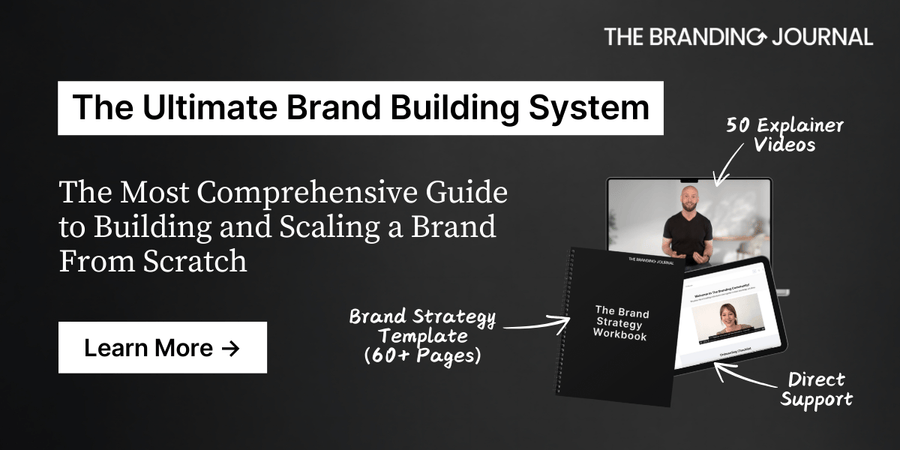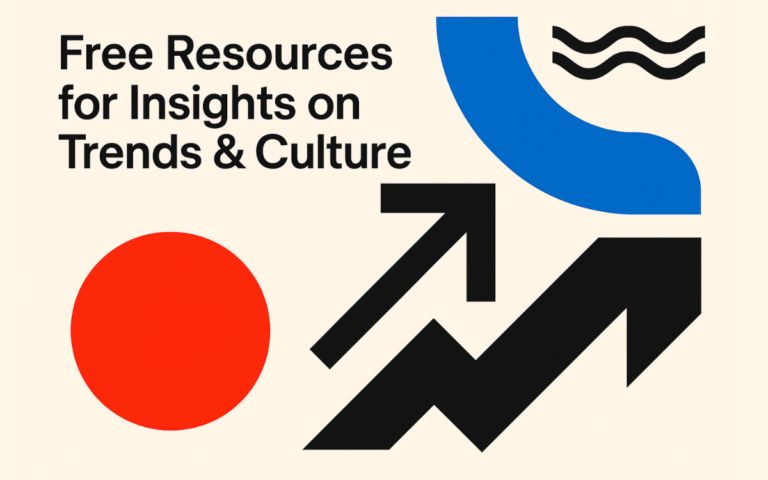Mastering strategic branding is a complex task.
In a world that changes quickly, with new brands appearing all the time and business rules evolving, it’s hard to keep up with trends and find special ways to build relevant brands.
To stay ahead of the curve and create effective brand strategies, it’s crucial to continuously develop and refine our skills as brand strategists.
I’ve been actively exploring ways to enhance my strategic thinking, and in this article, I’m excited to share seven domains I’m currently prioritizing. I hope you find it useful, and I’d love to hear your opinions and perspectives in the comment section below!
Proven Systems for Business Owners, Marketers, and Agencies
→ Our mini-course helps you audit and refine an existing brand in 15 days, just 15 minutes a day.
→ The Ultimate Brand Building System is your step-by-step blueprint to building and scaling powerful brands from scratch.
Table of Contents
#1 Research & Analysis
A brand strategy developed without prior research and analysis is not a solid one.
Brands navigate complex environments, and as strategists, we should make it a habit or a “motto” to base any strategy on the context in which it operates.
This includes researching and understanding what’s happening in the brand’s environment, what the brand’s resources and capabilities are, and what the brand’s stakeholders (including their ideal customers) truly need.
If you’re interested in improving this skill for brand strategies, here are some ideas you can incorporate into your daily life:
- Set some time each week to read industry news and reports
- Identify thought leaders in different industries and follow their work regularly
- Get regularly exposed to information related to society overall (e.g., politics, economics, environment, technology, laws, and policies) and try to identify patterns and trends
- Participate in industry forums, groups, and networks
- Analyze strategies of various brands (what works well and what could be improved)
- Practice active listening in your daily life to enhance relationships and gain diverse perspectives
- Incorporate methods for better understanding customers and other key audiences, such as conducting surveys or focus groups to gather direct feedback on preferences and needs
#2 Navigating Cultural Evolution
A few months ago, I read a very interesting article by Concept Bureau explaining that successful brands understand and navigate the cultural dynamics of their time.
By recognizing the different stages of cultural evolution – Entrenchment, Tension, Exploration, and Transformation – brands can strategically position themselves to drive change within their industry. I highly recommend the article to anyone looking to dive deeper into this topic.
Understanding this can have a profound impact on the work of any brand strategist. Learning to analyze and navigate cultural evolution is a strength that can help strategists define powerful positioning strategies that consider the factors of time and disruptive innovation. We’ll delve deeper into these two aspects later in this article.
But how can we better understand culture?
- A good starting point is to immerse yourself in documentaries, books, articles, and research on cultural trends and societal shifts.
- You can also keep a keen eye on trends in popular entertainment, social media, and online communities like Reddit and notice changes in values and social attitudes.
- Interacting with different sub-cultural groups can also be inspiring. Subcultural groups are smaller groups within a society that share distinctive values, norms, beliefs, and behaviors that differentiate them from the dominant culture. Subcultural groups can include various communities such as music enthusiasts, gamers, activists, or fashion subcultures, each with its own set of practices and symbols that define their identity and sense of belonging.
- Another option to explore is engaging with younger and older generations as well as different communities near you. You could also consider traveling to various regions and countries to experience the nuances of different geographical cultures firsthand.
#3 Deep Empathy
Brands are part of society, so they can impact or be impacted by a wide range of stakeholders. This includes customers, consumers, employees, competitors, investors, shareholders, partners, suppliers, the general public, local communities, and the natural environment.
To create relevant brands, we must put ourselves in the shoes of these diverse stakeholders and ensure that our brand strategies and actions meet their unique needs.
Deep empathy allows brand strategists to build brands that create meaningful connections with all their stakeholders. It is the foundation for building brands that not only deliver economic value but also contribute positively to society and the world.
Here are some ideas for cultivating empathy:
- Conduct interviews, focus groups and surveys to gather opinions, feedback, and insights
- Engage with customers on social media to understand their experience with the brand
- Practicing active listening in your daily life
- Read opinion pieces of people who offer different perspectives
- Participate in immersive experiences that expose you to different realities
Gathering feedback from stakeholders regularly and reflecting on how brand decisions might affect others can also help nurture an empathetic mindset.
You can also read our article about aesthetic empathy, which is a slightly different concept but also extremely relevant for brands.
#4 Ethical Branding & Sustainability Knowledge
This is quite a delicate topic, as many people associate brands and marketing with being the root of overconsumption and sustainability challenges. However, brands have a powerful role to play in the sustainability agenda.
In fact, brand strategy, which addresses crucial questions such as “Who are my brand’s stakeholders?”, “What is my brand’s purpose?”, “What are our values and principles?”, “What is our promise?”, and “What makes us unique?”, among many others, can lay the foundation for building better brands and a clear vision for the organization.
I am currently reading the book “Sustainable Marketing: The Industry’s Role in a Sustainable Future” by Paul Randle and Alexis Eyre. I wholeheartedly recommend it to anyone interested in understanding how marketing can be rethought to become part of the sustainability solution rather than a contributor to the problem.
By understanding the importance of ethical practices in branding and being well-informed about sustainability challenges, brand strategists can shift their mindsets and build brands that prioritize society and the environment. This approach not only contributes to a more sustainable future but also creates stronger and more resilient brands in the long run.
To nurture this skill, I could recommend:
- Reading about ethical branding and sustainable marketing
- Learning about the UN’s Sustainable Development Goals and browsing the UN free sustainability courses available on the SDG academy
- Learn about sustainable development, corporate social responsibility, and the circular economy by immersing yourself in books, courses, and insights shared by experts in the field
#5 Creativity
How could I write this article without mentioning creativity? Strategic thinking and the creative process go hand in hand. And in branding, creativity is the key ingredient that helps brands stand out, captivate audiences, and build strong emotional connections.
Cultivating creativity is a personal journey, and I’m sure many designers and artists will be much more qualified to advise on this matter.
My personal way of doing this is by testing hands-on, offline activities that are different from my daily work. Activities like drawing, photography, sewing, pottery, creating music or dancing are great ways to let our minds roam free and exercise our creative muscles. These creative areas can also later inspire your branding work.
Another idea to explore is to actively nurture curiosity. This means regularly exposing ourselves to the work of inspiring artists and creatives across various fields, allowing their ideas to expand our thinking. Also, when designing brand strategies, asking questions like “What if?” or “How might we?” helps explore new possibilities by pushing boundaries.
#6 Future-Thinking
Brand strategies are long-term by nature, and an essential skill for brand strategists is the ability to think ahead, identify trends, and predict future scenarios.
A future-thinking approach mitigates risks but also creates a much clearer vision for the brand’s future. With this information at hand, strategists and brand owners can also decide if the brand should follow the identified trends, considering all the uncertainties, or bet on larger ideas, beliefs, and behaviors that actively shape the future. This can be very powerful when combined with ethical and sustainable practices.
Here are some ideas to nurture a future-oriented mindset:
- Regularly scan for signals of change in consumer behavior, culture, laws, technology, etc., and consider their long-term implications
- Use scenario planning techniques to map out different possible futures for your brand and industry. Here are two interesting methodologies: Temporal Competitive Analysis and Design Future
- Collaborate with futurists and foresight experts to expand your knowledge of future methodologies
#7 Disruptive Innovation
For any product category, there are so many brands that co-exist. And it is our job as brand strategists to help organizations position their brands strategically, allowing them to stand out from the crowd.
The strongest brands often result from completely innovative products and business approaches. These brands are shifting how our culture evolves and providing solutions to people’s needs. Nurturing a disruptive innovation mindset helps us ask more relevant questions when building brands.
For disruptive innovation to be relevant, we need to consider all the points mentioned above: research and analysis, cultural understanding, empathy, ethical and sustainability considerations, creativity, and futurism.
But if you’re wondering how you could concretely work on this skill, here are some additional ideas to explore:
- Studying successful disruptive brands and analyzing what made them stand out/succeed
- Staying up-to-date on emerging technologies and considering how they could be used in new ways
- Collaborating with people with different profiles and from different backgrounds to spark fresh thinking and ideas
I hope you enjoyed this list, and that it will inspire your strategic mind! Developing expertise in these areas is a continual process, so don’t feel pressured to master every trend and insight—it’s simply not feasible. The goal is to exchange ideas and tools that can help us build better brands.
I’m excited to hear what you think and learn from all of you too.
Credits
- Cover Image: Photo by Ashkan Forouzani










